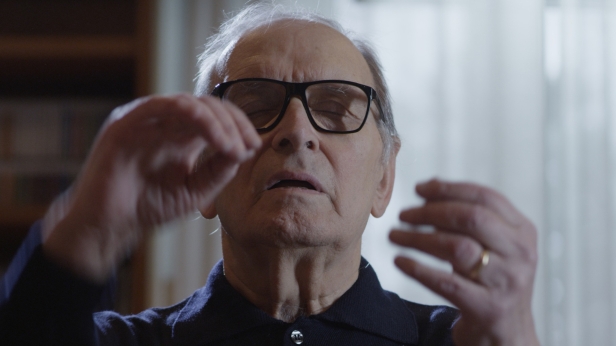In ‘Ennio,’ which opens this weekend at the Coolidge, director Giuseppe Tornatore (“Cinema Paradiso”) mixes archival interviews featuring Morricone, film clips, and conversations with directors such as Clint Eastwood, Quentin Tarantino, and more to craft a compelling documentary that delves into Morricone’s illustrious career.
By James Verniere/Boston Movie News
As someone weaned on John Ford Westerns, I was used to hearing “Shall We Gather at the River?” and “The Streets of Laredo.” Nothing prepared me for Ennio Morricone’s revolutionary score for Sergio Leone’s groundbreaking 1964 spaghetti western, “A Fistful of Dollars,” a wild, super-violent entry with many obviously dubbed actors, a distinctive, slashing, gunfire sound effect and that very tall guy from TV’s “Rawhide” playing the squinting, morally ambiguous, poncho-clad gunfighter.
Morricone’s music often sounds more like a collection of sound effects. I’d never heard whistling (usually courtesy of the multi-instrumentalist Alessandro Alessandroni) used in such a way, the slapping sounds, the triangle, an anvil (?). Was that an electric guitar? (Yes). In any case, it was thrilling.
“Ennio,” a documentary from director Giuseppe Tornatore of the Morricone-scored 1988 classic “Cinema Paradiso,” is the latest non-fiction film to celebrate the composer whose music forever changed the way films sound. Morricone, the son of a trumpet player, emerged from the post-war scene in Rome as an artist interested in “experimental music” and an accomplished and inventive arranger who became sought after in radio and television. Film was the obvious next realm for Morricone to conquer. But at the same time, his colleagues from the Saint Cecilia Conservatory, including surrogate father figure, composer Goffredo Petrassi, saw Morricone’s work in popular music as slumming.

“Ennio” comprises interviews with the maestro, who can be seen seated in a big armchair, inter-cut with new and archival footage of his films and collaborators, who include such directors as Bernardo Bertolucci (“1900”), Pier Paolo Pasolini (“The Decameron,” “Arabian Nights”), Terrence Malick (“Days of Heaven”), Brian De Palma (“The Untouchables”), Franco Zeffirelli (“Hamlet”), Roland Joffe (“The Mission”) and Tornatore himself. Quincy Jones, also a film composer, expresses love and admiration for his friend Morricone. We are reminded that Metallica plays Morricone’s theme “The Ecstasy of Gold” from “The Good, the Bad and Ugly” over the loudspeakers before all its shows. Metallica guitarist and frontman James Hetfield is a Morricone super-fan. Ditto for the Boss.
Morricone is nothing less than the Stephen King of film composition. He wrote so many film and TV scores that the maestro started using pseudonyms. One person interviewed in the film remembers Morricone continuing to score while talking on the phone. But why is it that Morricone’s friend and colleague, John Williams, has five Academy Awards and 54 nominations, while Morricone has only seven nominations, one competitive win (for Quentin Tarantino’s “The Hateful Eight”), and one honorary (2007)?
Only by watching this film did I learn that Morricone designed the music-free sound collage in the opening of “Once Upon a Time in the West” (1968)—the squeaking windmill, clicking telegraph, water dripping on Woody Strode’s bald head, and buzzing fly. Also, the first note played on Charles Bronson’s harmonica sounds eerily like the departing train blowing its horn. Brilliant.
Clint Eastwood, a musician in his own right and presenter of Morricone’s honorary Oscar, aptly describes Morricone as “innovative” and “operatic.” Lina Wertmuller (“I basilischi”) observes that Morricone is “a very peculiar man.” As someone else notes, like all of film’s greatest composers, you can always tell when you hear Morricone. Wong Kar-Wai, the film’s executive producer, adds that once you hear Morricone’s music, “you can’t forget it.” The maestro also collected water cans and used their clanging sounds in his compositions. How on earth did Morricone come up with that stylized “coyote howl” for “The Good, the Bad and the Ugly?” He repeatedly sings it for the camera. “Ya-da-ya-da-ya.” From where does such inspiration spring? Like the man’s genius, it’s a mystery.
‘Ennio’
Rating: Not Rated, no objectionable content
In Italian, French, English, Portuguese and Chinese
Cast : Ennio Morricone, Bernardo Bertolucci, Clint Eastwood, Giuseppe Tornatore, Quentin Tarantino Lina Wertmuller and many more
Director: Giuseppe Tornatore
Writer: Giuseppe Tornatore
Running Time: 2 hours, 36 minutes
Where to Watch: Coolidge Corner Theater and on digital April 9
Grade: A-
‘What’s the Score’
In celebration of the release of ‘Ennio,’ the Coolidge Corner Theater is presenting ‘What’s the Score,’ a repertory series showcasing films with iconic scores. Here’s the lineup:
April 2: THE GOOD, THE BAD AND THE UGLY – Ennio Morricone
April 3: KING KONG – Max Steiner
April 7: CINEMA PARADISO – Ennio Morricone
April 8: RYUICHI SAKAMOTO | OPUS
April 10: ROCKY – Bill Conti
April 16: SHAFT – Isaac Hayes
April 17: JOKER – Hildur Gundadottir
April 23: THE EMPIRE STRIKES BACK – John Williams
April 24: MERRY CHRISTMAS, MR. LAWRENCE – Ryuichi Sakamoto Tribute
April 30- THE SHINING – Wendy Carlos, Rachel Elkind